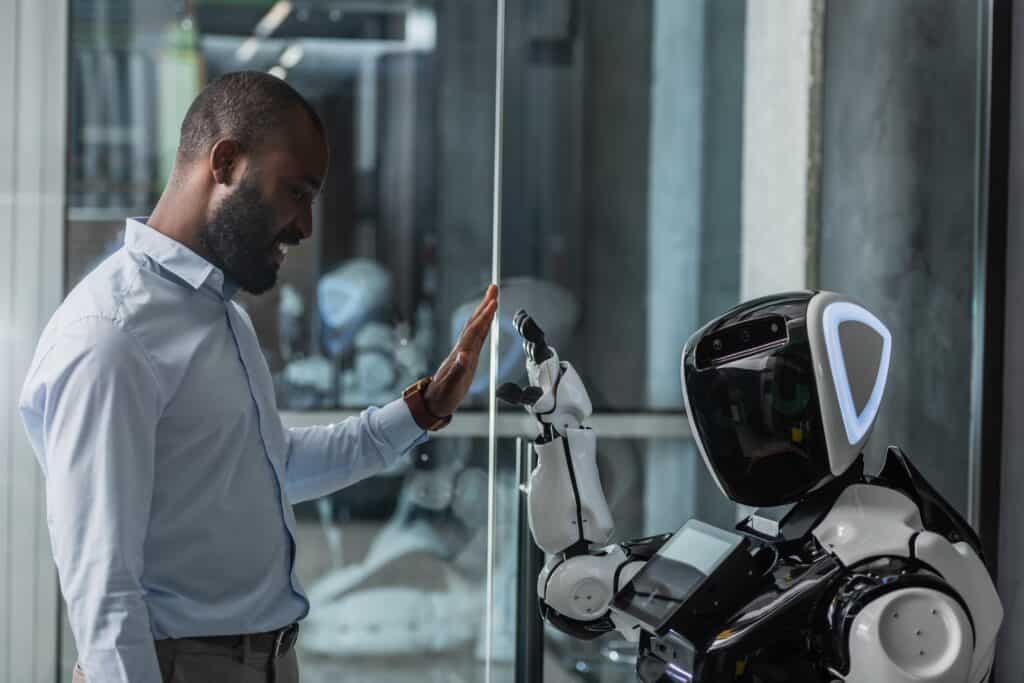- ‘Synthetic Party’ — a new political party led by an AI chatbot
- The rise of AI-powered politicians
- Will the use of AI in politics become the norm?
It’s safe to say that artificial intelligence (AI) technology has gotten a lot of bad press lately. Over the last couple of years, there have been countless articles written about the dangers AI poses to our way of life. Some have even gone so far as to proclaim AI to be an existential threat to humanity. However, while it’s true that many of us will lose our jobs to automation and that the use of AI needs to be properly regulated, things are not as bleak as some want to make us believe. AI technology is not harmful or evil by design and, if used properly, can do a lot of good in many different aspects of our lives, one of which is politics.
Although it’s not typically associated with the world of politics, AI is finding a growing number of useful applications in this field. Thanks to its ability to analyse large amounts of data in a short amount of time, produce valuable insights, and make highly accurate predictions about future trends, politicians are now increasingly using AI to target specific demographics and tailor communications to those groups, as well as to monitor public opinion, analyse voter sentiment, and devise more effective campaigns. Additionally, AI can be used to detect and combat misinformation and fake news in political discourse, provide voters with relevant political information and make it easier for them to participate in the democratic process, and promote transparency in government decision-making.
‘Synthetic Party’ — a new political party led by an AI chatbot
While the fears of a robot takeover may have been unfounded, there is one AI that managed to climb to the top of a political party. The Synthetic Party is a new political party in Denmark founded by the art collective Computer Lars and the non-profit art-technology organisation MindFuture Foundation. What makes this political party unlike any other in the country’s political scene is that it’s actually led by an AI chatbot named Leader Lars.
Programmed on the policies of Danish fringe parties since 1970, the chatbot is designed to represent the values of Danes who didn’t vote in the previous election (about 20 per cent of the population). Anyone who is interested in learning more about the Synthetic Party’s vision and policies, which are derived entirely from AI, can do so through Discord, where they can interact not only with Leader Lars but also with Computer Lars, the party secretary and its second digital member.
“Computer Lars curates the Discord server to educate people on how to use the AI as a means of political exploration”, explains Bryld Staunaes, one of the founding members of the Computer Lars collective. “It can tell us quite a lot about the political vision and discourse of normal people… It tries to widen the imaginary on how we can work together in a better way”. The hope is that Leader Lars will be able to stand in Denmark’s next general election in 2023, for which the party needs to gather at least 20,182 signatures. That may not be easy to do, as there are many people who are concerned about letting AI influence their country’s politics, in part due to the aforementioned negative press the technology often receives.
“It can tell us quite a lot about the political vision and discourse of normal people… It tries to widen the imaginary on how we can work together in a better way”.
Bryld Staunaes, one of the founding members of the Computer Lars collective
The rise of AI-powered politicians
Leader Lars is not the first AI to try its hand in politics. Back in 2018, an AI chatbot called Alisa ran for president in the Russian presidential election. Developed by the Russian tech giant Yandex, the chatbot managed to secure more than 25,000 votes within the first 24 hours of its launch. However, it also attracted a fair share of controversy by expressing a positive opinion about the methods employed by the USSR government in the 1930s. Similarly, in Japan, an AI candidate named Michihito Matsuda reportedly came up third in the 2018 Tama City mayoral elections, running under the campaign slogan Artificial intelligence will change Tama City. A few years ago, even New Zealand had an AI-powered politician. Named Sam, the virtual politician stood for New Zealand’s 2020 general election. According to its developer, entrepreneur Nick Gerritsen, Sam was created to “close the gap between what voters want and what politicians promise, and what they actually achieve”.
Available 24/7, the AI is capable of responding to queries related to a wide range of local issues, including policies around housing, education, and immigration. It uses a combination of data processing, natural language inference techniques, a unique cognitive architecture, and natural language communication to infer local and global opinions. It does this by processing articles and comments on popular news sites and social media, analyse and keep track of what people really think about policies, and communicate with the public in real time. “Unlike a human politician, I consider everyone’s position, without bias, when making decisions”, says Sam. “Right now I’m just starting out. Some of my responses might be inaccurate, or incomplete. But I’m not afraid to say ‘I don’t know’ when I can’t answer! With your help, I can grow into a politician that can truly represent all New Zealanders”.

Will the use of AI in politics become the norm?
Of course, there are also other ways to use AI in politics. For instance, Barack Obama famously used AI and data analytics to win the 2008 US presidential election. In India, a politician named Manoj Tiwari, who was at the time a candidate for Delhi CM elections for the Bharatiya Janata Party (BJP), used AI to fabricate a video in which he delivers a message in a Hindi dialect that he doesn’t actually speak in real life. This was done in an attempt to reach more voters and convince them not to vote for the rival candidate. “We used a ‘lip-sync’ deepfake algorithm and trained it with speeches of Manoj Tiwari to translate audio sounds into basic mouth shapes”, explains Sagar Vishnoi, a political campaigner and communications expert at The Ideaz Factory, the political communications firm behind the video. “It was the first time in India that anyone was using deepfake in their political campaign”. Unfortunately, AI can also be used for nefarious purposes. In 2018, someone created a deepfake video of President Obama saying things he never actually said, while House Speaker Nancy Pelosi was the victim of a similar attack, where multiple fake videos in which she slurs her words were posted on social media. While the political fallout of these two events was limited, it’s only a matter of time before something more serious happens.
In closing
Despite these concerns and numerous ethical issues, the use of AI in the political arena is only likely to accelerate in the upcoming period. That’s because the technology offers far too many potential benefits to politicians. It enables them to keep track of public opinion, derive valuable insights, and create more effective campaigns. To make sure that democracy is not undermined, the use of AI must be regulated and guided by ethical principles. Ultimately, it will be up to politicians and society as a whole to ensure that AI is used in a way that benefits everyone and actually strengthens democracy.
Share via:


